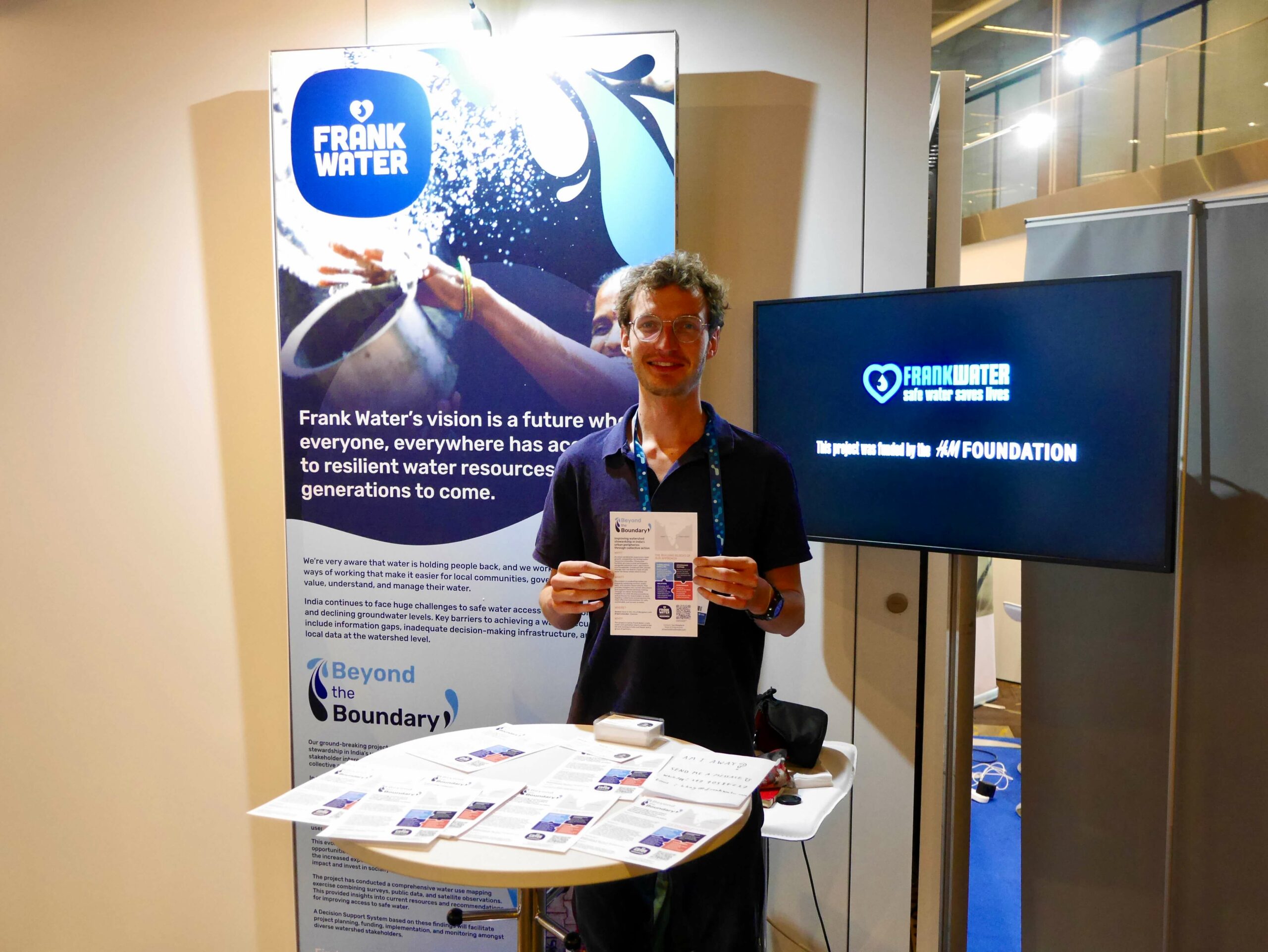Frank Water attends World Water Week
05.09.23
By subscribing to our newsletter, you give us permission to email you with news of our work and events, plus opportunities for volunteering, challenges to take part in and special offers in our shop. You can unsubscribe any time by clicking the link in our email footer.

05.09.23

World Water Week (20-24 August) is a high point on the calendar for thousands of people from across the globe, and since 1991 the Stockholm-based gathering has described itself as the leading conference on global water issues. As someone passionate about water management, the gathering has long been on my radar. This year, I had the opportunity to host a small stand at this famous gathering to talk about our Beyond the Boundary Project. Our project aims to actualise collective action in two watersheds in India, which essentially means getting the local government, corporate production sites, and local communities to work together to secure safe and sustainable water for future generations – especially in the face of climate change.
And World Water Week, or SIWI as it is colloquially known after the organising Stockholm International Water Institute, was the perfect opportunity to promote the project, find new partners, and test our ideas with true experts in the field. Over five days, as I dashed from engaging conversations at our exhibition stand to a plethora of workshops, seminars, and discussion groups, I learned a huge amount not just about the water crisis but about how our project can grow and evolve in years to come.
This year, thousands of participants, exhibitors, speakers, and volunteers from over 193 countries gathered in Stockholm. Across 300 sessions, across lunch tables, around stands, and occasionally in noisy pubs, small and large non-governmental organisations waxed lyrical about their work, whilst consultants and specialists sought future opportunities whilst rubbing shoulders with transnational giants such as the World Bank and the United Nations. The corporate nature of some aspects of the event is in stark contrast to the youthful feel of much of the conference, with around 42% of attendees being under 35. Water innovations from young people take a leading position at the event, and a rowdy water-related pub quiz and side party for job-hunters, all arranged by young people, were the social highlights. The juxtaposition of corporate heavyweights in luxurious hotels mingling with young volunteers and activist-types staying in hostels and guesthouses could in some ways seem perplexing, but it’s perhaps one of the few events where such a juxtaposition can really work.
The theme for this year’s conference was Seeds of change – innovations for a water-wise world, and it was made clear from an early stage that the innovation we need to solve the water crisis isn’t just about technology, but about rethinking approaches and ways of framing problems. Certain buzzwords abounded, and if there was a criticism I could make it was the vapid repetition of maxims such as ‘co-creation’, ‘rethinking’, ‘collective action’, and ‘stewardship’ during some sessions. However, this was more than compensated by the huge depth and breadth of knowledge, wisdom, and experience to be found – some of which, I would like to share.
Community participation, engagement, and empowerment were also strong themes, and a thread that wound through many sessions. The Ganga River Basin in India was the subject of several sessions, historically known for both its essential spiritual value and pollution, but now the subject of enormous efforts to improve water quality through catchment work. Inspiring work has been done by the National Mission for Clean Ganga with communities to actively engage in river conservation. Another workshop, hosted by Lincoln Institute of Land Policy’s Consortium for Scenario Planning, introduced participatory scenario planning, where participants investigate possible future uncertain scenarios that could affect their lives. The principle was, rather than trying to predict the future or set out normative desired futures, to explore a plethora of possible different futures and examine which could be most likely and how to prepare for them.
Stewardship, in particular, how corporate production sites can act as stewards of water resources in their watersheds, was also an extremely common theme, with a strong presence from international clothing manufacturers. WWF plays a significant role in supporting corporate supply chains and appeared at several sessions, including introducing it’s Water Risk Suite. Steps include increasing awareness of water risks, performing technical training with corporations, and performing on-site water assessments and cost-benefit analyses for potential solutions. The targeting of interventions was based on factors such as the presence of conservation sites, concentrations of industries, levels of pollution, and location in relation to supply sites. They acknowledged that barriers to engaging in water stewardship included not just finance, but policies, frameworks, and incentives for companies to engage in the first place – exactly what we are trying to do at Beyond the Boundary!
Beyond frameworks, policies, and procedures, there was an impressive array of technical competence at World Water Week. Many visitors to our exhibition stand were interested in how Beyond the Boundary had used modelling – combining earth-observation, government, and community-level data – to assess the impact of climate scenarios on water security. However, as was evident, the modelling world is making leaps and bounds. Approaches such as agent-based modelling consider not just physical systems, but the role that communities and the decisions they make could play in the water cycle. For example, how could decisions around future cropping patterns or irrigation affect water security? How could water demand change as lifestyles change? In an uncertain world, these are doubtless relevant considerations to capture in any model. The provenance of global data portals is also on the rise. The Food and Agricultural Organisation presented their WaPOR tool for water productivity, which is shortly to be extended for global reach. Similar data portals are being used to provide hyper-local advice on irrigation scheduling for farmers, such as IMISET in Ethiopia with publicity also given to Jaltol from WELL Labs. Practical on-the-ground solutions were also on show – I was particularly impressed by the work of ICRISAT, The International Crops Research Institute for the Semi-Arid Tropics, and their work dramatically improving agricultural productivity with water-related interventions.
In summary, the conference was a whirlwind of people and ideas that can enrich the work we do with Beyond the Boundary and Frank Water, and contribute towards Sustainable Development Goal 6 – clean water and sanitation for all. Ironically, as I was starting to write this blog on the last stage of my long journey from Stockholm back to my home in Trondheim, Norway, my route was completely cut off – the road had collapsed and the railway damaged close to the Norwegian-Swedish border due to heavy rain. Around a week before, a seemingly solid iron railway bridge from the 1950s, a key link between northern and southern Norway, collapsed into the river under the unprecedented weight of the water. The transforming hand of climate change was wreaking havoc here, and doing much worse in other parts of the world. World Water Week is in many ways a comfortable and enclosed experience. Whilst indigenous knowledge around water made a stellar appearance, the bottom line was still strongest, and risks were often framed in terms of business risks as opposed to risks to the human rights of billions of people. Nevertheless, such an environment may be necessary for bringing together a unique set of people. Is there another place where a proud minister, a sharp corporate CEO, and a water activist could rub shoulders? Would another venue exist to allow face-to-face debate and problem-solving to address the water crisis?
Either way, I look forward to physically and mentally sifting through the reams of notes and contacts from the conference, building collaborations, and taking Beyond the Boundary forward. Thank you, Stockholm!

Stockholm’s Old Town